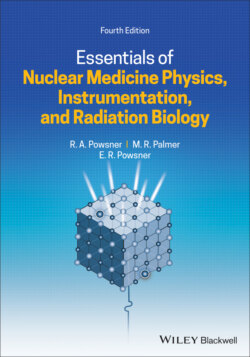Читать книгу Essentials of Nuclear Medicine Physics, Instrumentation, and Radiation Biology - Rachel A. Powsner - Страница 32
Energy of beta particles and positrons
ОглавлениеAlthough the total energy emitted from an atom during beta decay or positron emission is constant, the relative distribution of this energy between the beta particle and antineutrino (or positron and neutrino) is variable. For example, the total amount of available energy released during beta decay of a phosphorus‐32 atom is 1.7 MeV. This energy can be distributed as 0.5 MeV to the beta particle and 1.2 MeV to the antineutrino, or 1.5 MeV to the beta particle and 0.2 MeV to the antineutrino, or 1.7 MeV to the beta particle and no energy to the antineutrino, and so on. In any group of atoms the likelihood of occurrence of each of such combinations is not equal. It is very uncommon, for example, that all of the energy is carried off by the beta particle. It is much more common for the particle to receive less than half of the total amount of energy emitted. This is illustrated by Figure 1.17, a plot of the number of beta particles emitted at each energy from zero to the maximum energy released in the decay. Eβmax is the maximum possible energy that a beta particles can receive during beta decay of any atom, is the average energy of all beta particles for decay of a group of such atoms. The average energy is approximately one‐third of the maximum energy or
Figure 1.17 Beta emissions (both β– and β+) are ejected from the nucleus with energies between 0 and their maximum possible energy (Eβmax). The average energy () is equal to approximately one third of the maximum energy.
